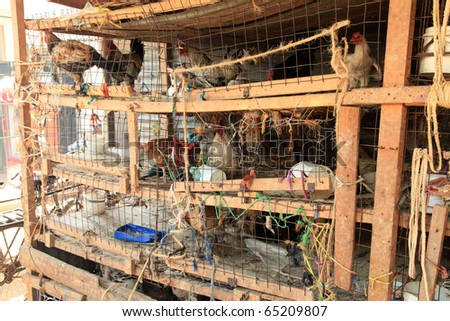 From 1996-98, I was a Peace Corps Volunteer in Togo, West Africa. I lived in the village of Blitta without water or electricity. Just before making a trip to the Peace Corps office at Lomé at the end of January 1997, I noticed a very young black hen in our yard one morning. She had two broken legs and couldn't move. No one in my African host family owned a chicken, and it didn't seem to belong to any of the neighbors, as no one came looking for it. Animals for the most part run free in the village. Most Togolese don't have money for fencing. The free-roaming animals eat up any scrap of anything even remotely edible that is dropped anywhere, and things are dropped everywhere.
From 1996-98, I was a Peace Corps Volunteer in Togo, West Africa. I lived in the village of Blitta without water or electricity. Just before making a trip to the Peace Corps office at Lomé at the end of January 1997, I noticed a very young black hen in our yard one morning. She had two broken legs and couldn't move. No one in my African host family owned a chicken, and it didn't seem to belong to any of the neighbors, as no one came looking for it. Animals for the most part run free in the village. Most Togolese don't have money for fencing. The free-roaming animals eat up any scrap of anything even remotely edible that is dropped anywhere, and things are dropped everywhere. It's the custom for people to eat outside in the yard, as the tin roofed houses have the ambience of an oven. They drop bones on the ground, and during food preparation the women drop peels and kitchen garbage on the ground. Pygmy goats and occasional ducks or chickens which wandered through our yard would eat some of these scraps. Villagers don't have money for animal vaccinations, much less for animal feed, so for the animals it was eat everyone's garbage or eat nothing. Since there were no fences in this village, it wouldn't be out of the ordinary to see a chicken in our yard. No one came looking for it because people didn't seem to keep track of their animals unless perhaps they were about to become dinner. None of the people who passed through our yard paid any attention to it at all. If it were diseased, that would be prudent. I overcame my initial desire to help the injured creature and asked Colette, my host mother, what happened to the little black hen.
It's the custom for people to eat outside in the yard, as the tin roofed houses have the ambience of an oven. They drop bones on the ground, and during food preparation the women drop peels and kitchen garbage on the ground. Pygmy goats and occasional ducks or chickens which wandered through our yard would eat some of these scraps. Villagers don't have money for animal vaccinations, much less for animal feed, so for the animals it was eat everyone's garbage or eat nothing. Since there were no fences in this village, it wouldn't be out of the ordinary to see a chicken in our yard. No one came looking for it because people didn't seem to keep track of their animals unless perhaps they were about to become dinner. None of the people who passed through our yard paid any attention to it at all. If it were diseased, that would be prudent. I overcame my initial desire to help the injured creature and asked Colette, my host mother, what happened to the little black hen.
Grab The Bookmarketer For Your Site



